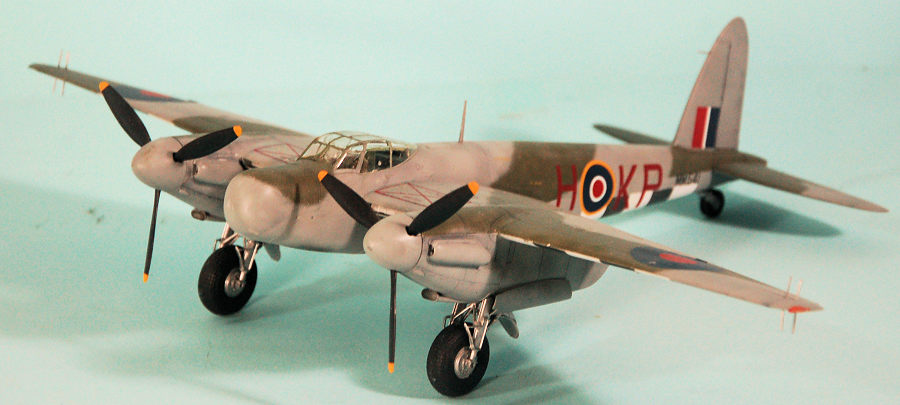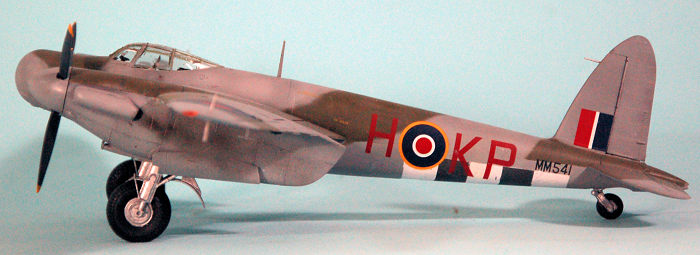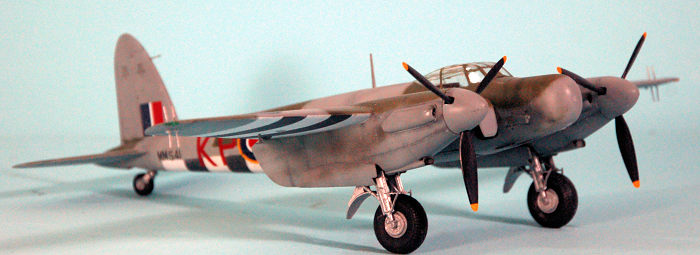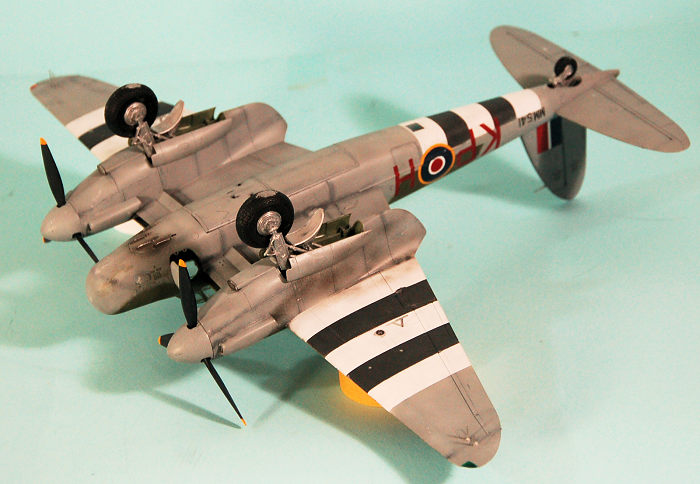
Tamiya 1/48 Mosquito NF XIII/XVII
| KIT #: | 61075 |
| PRICE: | $38.00 'used' |
| DECALS: | Two options |
| REVIEWER: | Tom Cleaver |
| NOTES: | Kit removed from production; available only from collectors |

| HISTORY |
Once deHavilland received a production order in January 1940 for one prototype of the D.H. 98 design as an unarmed bomber to specification B.1/40/dh, the contract was modified on March 1, 1940 under Specification B.1/40 for 50 bomber-reconnaissance variants of the DH.98. In May 1940, specification F.21/40 was issued for a long-range fighter armed with four 20 mm cannon and four .303 machine guns in the nose; de Havilland was authorized to build a prototype of a fighter version of the DH.98. By June 1940, the DH.98 had been named "Mosquito". The fighter variant kept the Mosquito project alive in the face of continued criticism of the usefulness of an unarmed bomber.
The Mosquito Night Fighter:
 Night fighter ace Wing Commander John Cunningham flew the Mosquito
prototype W4050 on 9 February 1941. He was greatly impressed by the "lightness
of the controls and generally pleasant handling characteristics". Cunningham
concluded that when the type was fitted with AI equipment, it might replace the
Bristol Beaufighter night fighter
Night fighter ace Wing Commander John Cunningham flew the Mosquito
prototype W4050 on 9 February 1941. He was greatly impressed by the "lightness
of the controls and generally pleasant handling characteristics". Cunningham
concluded that when the type was fitted with AI equipment, it might replace the
Bristol Beaufighter night fighter
Construction of the fighter prototype, W4052 was also carried out at the secret Salisbury Hall facility. The aircraft was powered by 1,460 hp Merlin 21s and featured an altered canopy structure with a flat bullet-proof windscreen and a solid nose that mounted four .303 British Browning machine guns and their ammunition boxes, accessible by a large, sideways hinged panel. Four 20 mm Hispano Mk II cannon were housed in a compartment under the cockpit floor with the breeches projecting into the bomb bay and the automatic bomb bay doors were replaced by manually operated bay doors, which incorporated cartridge ejector chutes.
W4052 was equipped with AI Mk IV equipment including an "arrowhead" transmission aerial mounted between the central machine guns with receiving aerials mounted through the outer wing tips and it was painted in black RDM2a "Special Night" finish. W4052 was later tested with other modifications including bomb racks, drop tanks, barrage balloon cable cutters in the leading edge of the wings, Hamilton airscrews and braking propellers, as well as drooping aileron systems that enabled steep approaches and a larger rudder tab. The prototype continued to serve as a test machine until it was scrapped on 28 January 1946.
 The prototype Mosquito NF II first flew on May 15, 1941. A total of 466
NF II aircraft were built and the type first entered operational service with
157 Squadron in January 1942. The Mosquito quickly replaced the Defiant N.F. I
and II as fast as production would allow. The Mosquito night fighters were
particularly effective in blunting Operation Steinbock (the “mini-blitz”) in
early 1944. Within a month of commencing operations, Mosquito night fighters
began raiding Luftwaffe airfields in the intruder role in July 1942.
The prototype Mosquito NF II first flew on May 15, 1941. A total of 466
NF II aircraft were built and the type first entered operational service with
157 Squadron in January 1942. The Mosquito quickly replaced the Defiant N.F. I
and II as fast as production would allow. The Mosquito night fighters were
particularly effective in blunting Operation Steinbock (the “mini-blitz”) in
early 1944. Within a month of commencing operations, Mosquito night fighters
began raiding Luftwaffe airfields in the intruder role in July 1942.
In answer to increased losses of RAF bombers to German night fighters in 1943, Mosquito night fighter squadrons were assigned to 100 Group. Initially, only Mosquito NF II fighters still equipped with A.I. Mk. IV were utilized since the RAF did not want to give away the centimetric radar if one was lost over Germans. These RCM (radio countermeasures) aircraft were fitted with a device called "Serrate" that homed in on the Lichtenstein B/C (low-UHF-band) and Lichtenstein SN-2 (lower end of the VHF FM broadcast band) radar emissions, as well as a device named "Perfectos" that tracked German IFF signals. Following the realization that the loss of bombers equipped with H2S had “given away” centimetric radar, later night fighters so equipped began operations over Germany following the invasion of Europe. The Mosquitos used against German night fighters and those intruders that went after Luftwaffe night fighter air bases destroyed 257 German aircraft between December 1943 and April 1945. Mosquito fighters from all units accounted for 487 German aircraft during the war, the vast majority of which were night fighters.[
Development of centimetric radar further enhanced the ability of the Mosquito night fighter. 97 NF Mk IIs were upgraded with 3.3 GHz frequency, low-SHF-band AI Mk VIII radar, designated NF XII. The 270 NF Mk XIIIs were the production equivalent of the Mk XII conversions, based on the FB VI airframe. The "centimetric" radar was housed in a solid "thimble" nose on the Mk XII and the first 100 NF XIII, after which the universal "bull nose" radome, which allowed use of either British A.I. Mk.VII or U.S. SCR-270 (known to the British as AI Mk. X) radars. A further 99 NF II airframes were modified with the “bull nose” to use either radar, and were designated NF XVII. A further 220 NF XIX night fighters produced with FB VI airframes were built in 1944. The 526 NF Mk 30s were the final wartime variant, which used the AI Mk. VIII radar; this was a high-altitude version, powered by two 1,710 hp Rolls-Royce Merlin 76s with two-stage superchargers. The NF XXX had a maximum speed of 424 mph at 26,500 ft, some 30 mph faster than the earlier night fighters.
 There were a total of 58 Mosquito night fighter and intruder pilots
credited with 5 or more victories as “aces.” Among the top-scorers was Canadian
Wing Commander “Bob” Braham with 29 (12 scored on the Mosquito, the rest with
the Beaufighter). Wing Leader Brance A. Burbridge was the top-scoring
all-Mosquito ace with 21 victories, all scored while flying with 85 Squadron.
The first Mosquito night fighter claim was made by a 151 Squadron NF II in May
1942, with the last made the night of 25/26 April 1945 by a NF XXX of 488
Squadron. Twenty aces flew with 85 Squadron, the top-scoring RAF night fighter
unit. The top-scoring RCAF night fighter squadron was 409 “Nighthawk” squadron.
There were a total of 58 Mosquito night fighter and intruder pilots
credited with 5 or more victories as “aces.” Among the top-scorers was Canadian
Wing Commander “Bob” Braham with 29 (12 scored on the Mosquito, the rest with
the Beaufighter). Wing Leader Brance A. Burbridge was the top-scoring
all-Mosquito ace with 21 victories, all scored while flying with 85 Squadron.
The first Mosquito night fighter claim was made by a 151 Squadron NF II in May
1942, with the last made the night of 25/26 April 1945 by a NF XXX of 488
Squadron. Twenty aces flew with 85 Squadron, the top-scoring RAF night fighter
unit. The top-scoring RCAF night fighter squadron was 409 “Nighthawk” squadron.
| THE KIT |
 The night fighter Mosquito was the last version of this famous airplane
to be released by Tamiya, appearing in 2000, following the FB VI in 1998 and the
B Mk IV in 1999. This was the lowest-seller (for some reason, many modelers
don’t like the “bull nose,” which to me makes the airplane even more
pugnacious), and the kit is currently withdrawn from further production. Tamiya
has released a 1/72 NF XIII/XVII which is still available. The only other 1/48
Mosquito night fighter kit released was an NF 30 by Airfix in the late 1980s; it
is a mish-mash of their earlier FB VI kit, with the high-altitude Merlin “long”
cowling nacelles and an extra fuselage with the “bull nose”.
The night fighter Mosquito was the last version of this famous airplane
to be released by Tamiya, appearing in 2000, following the FB VI in 1998 and the
B Mk IV in 1999. This was the lowest-seller (for some reason, many modelers
don’t like the “bull nose,” which to me makes the airplane even more
pugnacious), and the kit is currently withdrawn from further production. Tamiya
has released a 1/72 NF XIII/XVII which is still available. The only other 1/48
Mosquito night fighter kit released was an NF 30 by Airfix in the late 1980s; it
is a mish-mash of their earlier FB VI kit, with the high-altitude Merlin “long”
cowling nacelles and an extra fuselage with the “bull nose”.
The Tamiya kit provides decals for two aircraft: an NF XIII night fighter of 409 Squadron RCAF and an NF XVII intruder of the specialist Night Fighter Interception Unit. There are aftermarket decal sheets for the night fighter that can still be found with dealers on the internet at reasonable prices.
| CONSTRUCTION |
Having had success with the FB VI kit, I built this one the same way, starting with painting all detail parts on the sprue trees, then assembling the landing gear as their own sub-assemblies, followed by the wings and finally the fuselage. As with the earlier kit, if you take your time with fitting things together, you will not need any filler anywhere.
| COLORS & MARKINGS |
 Again, since we are celebrating the 75th anniversary of the final year
of World War II, I decided to paint and mark this model as a Mosquito XIII
operated by 409 “Nighthawk” squadron shortly after the unit’s transfer from the
UK to France in the fall of 1944. I found a photograph of a 409 Mosquito with
the D-Day stripes still on the lower fuselage and underside of the wings, and
decided to do that.
Again, since we are celebrating the 75th anniversary of the final year
of World War II, I decided to paint and mark this model as a Mosquito XIII
operated by 409 “Nighthawk” squadron shortly after the unit’s transfer from the
UK to France in the fall of 1944. I found a photograph of a 409 Mosquito with
the D-Day stripes still on the lower fuselage and underside of the wings, and
decided to do that.
After painting and masking the D-Day stripes, the rest of the model was painted in the standard Night Fighter Scheme of overall Sea Grey Medium, using Tamiya XF-83, with a disruptive pattern of Dark Green, using Tamiya XF-81. When completed, I unmasked the stripes and gave the model an overall coat of clear gloss varnish.
I used the kit decals, which are thick, but go down nicely under Solvaset. I modified the kit supplied markings to make KP-H/MM541, the Mosquito I found a photograph of.
After washing the model to get rid of decal solvent residue, I applied several coats of Clear Flat to get the final finish I wanted. I unmasked the canopy, then attached the landing gear, and finally the open crew door.
| CONCLUSIONS |
If you want a Mosquito night fighter in the final configuration, this is the only kit out there. I found this one on eBay and my winning bid of $38.00 was the original selling price of the kit, with shipping included. You cannot get the kit otherwise, and you should shop around, because I found prices as high a $50.00+ being asked.
This is an excellent kit, easy to build, and it makes up into a very nice model. Anyone with a little experience building kits will have no problem with this if you commit the revolutionary act of following the instructions. Highly recommended.
9 May 2019
Review kit courtesy of my wallet.
If you would like your product reviewed fairly and fairly quickly, please contact the editor or see other details in the Note to Contributors.
Back to the Main Page Back to the Review Index Page Back to the Previews Index Page